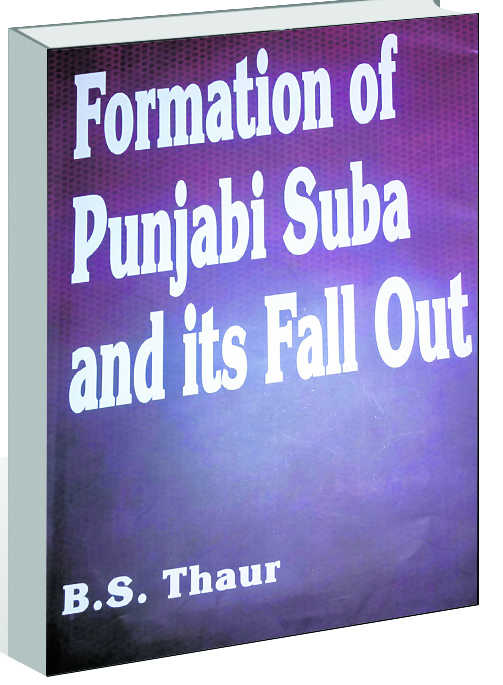Kuldip Singh Dhir
The idea of states based on languages was mooted by the Indian National Congress as early as 1917. It seems strange that the demand for Punjabi Suba in consonance with the avowed policy of the Congress was countered the maximum by the party itself, though Punjabi Hindus were also misled to oppose it.
BS Thaur’s book gives an authentic account of struggle for the cause and its fallout due to inapt handling of the issue. At the time of the Partition, Sikh leaders threw their lot with India, hoping for a special treatment in the new setup, which they had been assured by the Congress. The new constitution did not introduce any such provision. The education policy of the first Chief Minister of Punjab, Gopi Chand Bhargava, came as an immediate irritant. He allowed both Punjabi and Hindi as the medium of teaching children, leaving the choice to the individual. As many Hindus disowned the language by claiming that Punjabi was only a dialect or at best a vehicle of their cultural expression, communal tensions began to rise. The cleavage widened when Hindu press propagated vociferously that Akali leaders were actually after a Sikh state, which had no room in secular India.
The Akalis, led by Master Tara Singh, decided to hold a conference in Delhi in 1949 to explain their viewpoint. He was arrested to foil the attempt. Subsequent to it, an Akali conference was held in Amritsar and demand for a Punjabi-speaking state was made.
Bhim Sen Sachar, the then CM, came out with Sachar formula to diffuse tensions over the language issue. It envisaged division of Punjab into Hindi and Punjabi-speaking zones. The formula did not go well with propagators of either language. While Akalis raised the issue vehemently, the Congress and Arya Samajis opposed it. The Congress was constrained by political compulsions, which did not allow strengthening of Sikhs. Those from Arya Samaj were obsessed with the idea that Sikhs branched out from Hindus as a historical necessity, and in the changed scenario, they should get absorbed into the Hindu fold.
This narrative tells that 1951 census vitiated the atmosphere further. A large section of Hindus declared Hindi as their mother tongue. This received a strong reaction from Akalis, making Punjabi Suba the main plank of their election manifesto in 1952. They were successful in forming first non-Congress government in independent India in PEPSU. It was dismissed by central government, creating further bitterness. Also, State Reorganisation Commission was appointed in 1953. Meanwhile, the Congress made a bid to snatch control of SGPC to weaken the Akali Dal. Having failed there too, the government banned the shouting of slogans for Punjabi Suba.
The Akalis launched a morcha challenging all bans. A climax was reached when police entered the Golden Temple. It sent shock waves throughout the Sikh world. The government lifted the ban and CM Sachar tendered a public apology. Goodwill generated by him was dissipated shortly afterwards with State Reorganisation Commission rejecting the demand for the Suba. Seeing the Akalis on their toes again, a compromise known as regional formula was announced in 1956.
The Akalis picked up the threads again in 1960. The clandestine ousting of Master Tara Singh from SGPC, appointment of a Congress Sikh in his place, non-implementation of the regional formula and eviction of Sikh settlers in Rudrapur (UP) have been enumerated as the reasons that precipitated new confrontation. In what the author has described as a reign of terror, some 50,000 Sikhs were jailed and many lives were lost. Sant Fateh Singh and Master Tara Singh observed fasts unto death. Mediation by eminent Sikhs and national figures like JP Narayan, Ashok Mehta, Saif-Ud-Din Kitchlu and C Rajagopalachari salvaged the situation. Government set up a commission to look into charges of discrimination against the Sikhs, which absolved government of all such charges and dismissed the demand for Punjabi Suba.
Thaur’s narrative points out that Chinese aggression of 1962 and Indo-Pak confrontation of 1965 turned around the situation. Sikh leaders put the Punjabi Suba issue on the backburner and exhorted Sikhs to help the country fight the enemy first. Pratap Singh Kairon’s ignominious exit from the position of power and death of Jawaharlal Nehru also blunted the opposition to the Sikh demand. Government then announced a cabinet sub-committee to find a solution. Accepting its report, the Congress Working Committee recommended the carving out of a Punjabi-speaking state. The Act for reorganisation of Punjab was signed and the dream for Punjabi Suba became a reality in 1966.
Thaur underlines the fact that the euphoria of the historical event waned steadily due to the lacunae left during the formation of Punjabi Suba. The Akalis had to take constant recourse to agitations to get these remedied. The Sikhs and the Centre never felt comfortable with each other in the 50 years that followed. This book recounts the long chain of events of the crisis, which was the result of this confrontation.
The meticulous and incisive analysis leaves us with two significant conclusions. First, the act of reorganisation of Punjab reflects disbelief and lack of confidence in the rulers of Punjab. Common links, central control over important projects and leaving out some Punjabi-speaking areas sowed seeds of long-term discontent. Second, power hungry politicians and their rivalries for one-upmanship have played havoc with Punjab. Be it formation of Punjabi Suba or its fallout, Punjab and Punjabis continue to suffer. They still await justice which seems to be a far cry.
Unlock Exclusive Insights with The Tribune Premium
Take your experience further with Premium access.
Thought-provoking Opinions, Expert Analysis, In-depth Insights and other Member Only Benefits
Already a Member? Sign In Now










